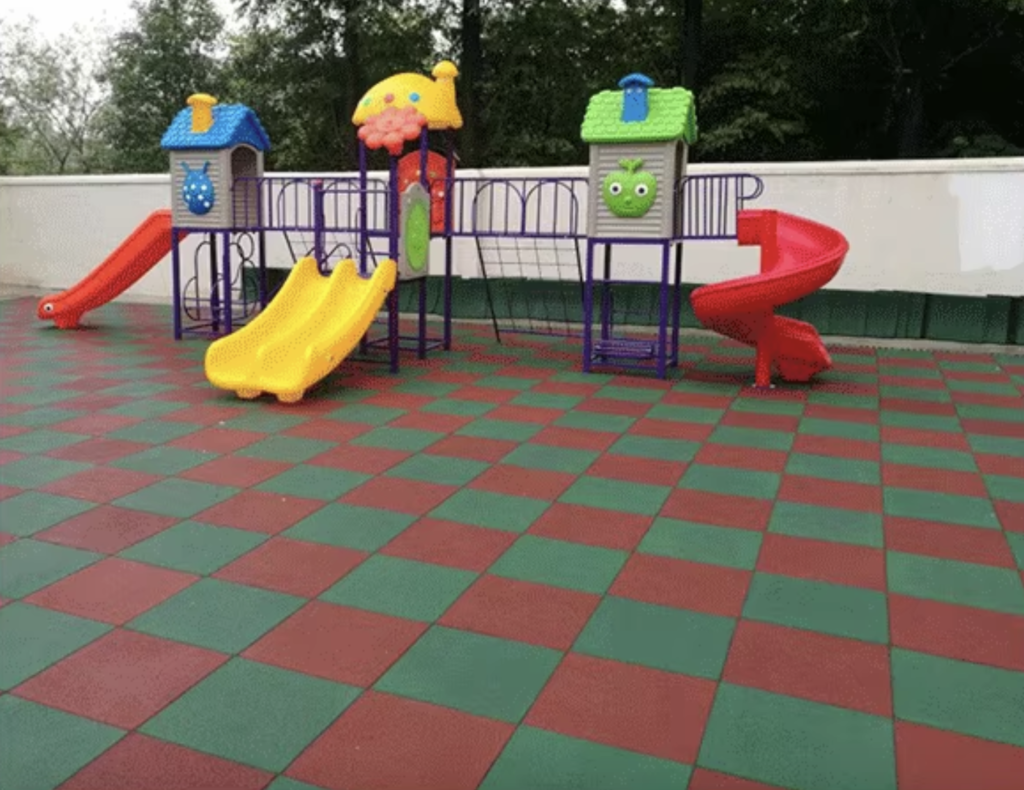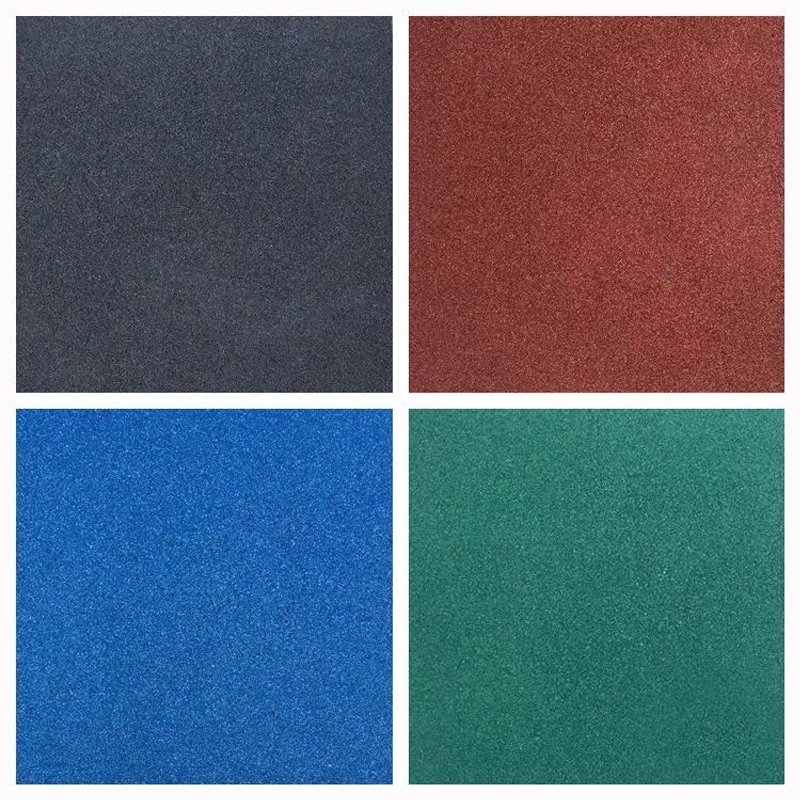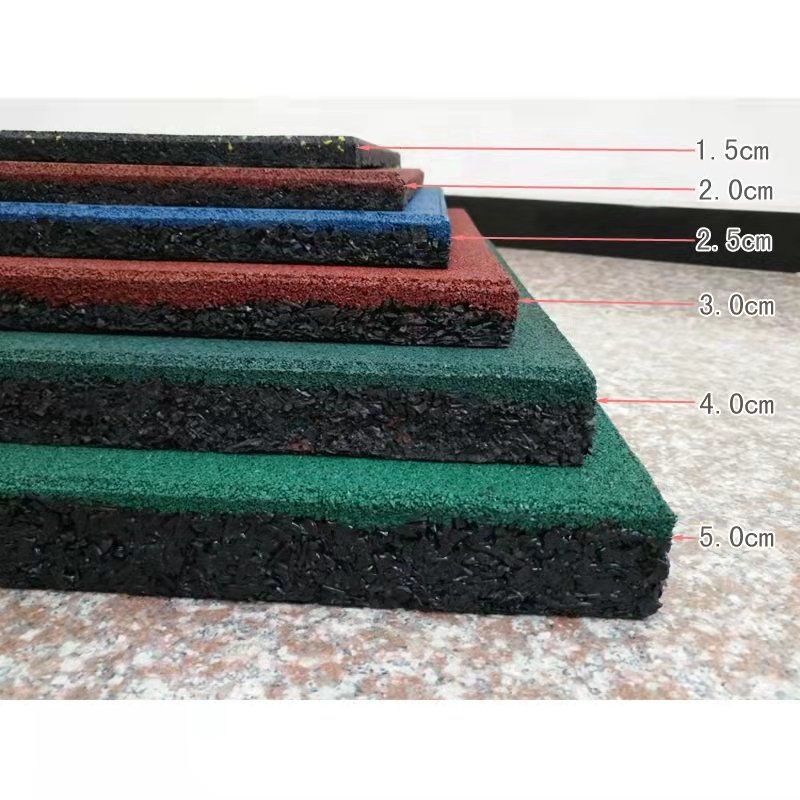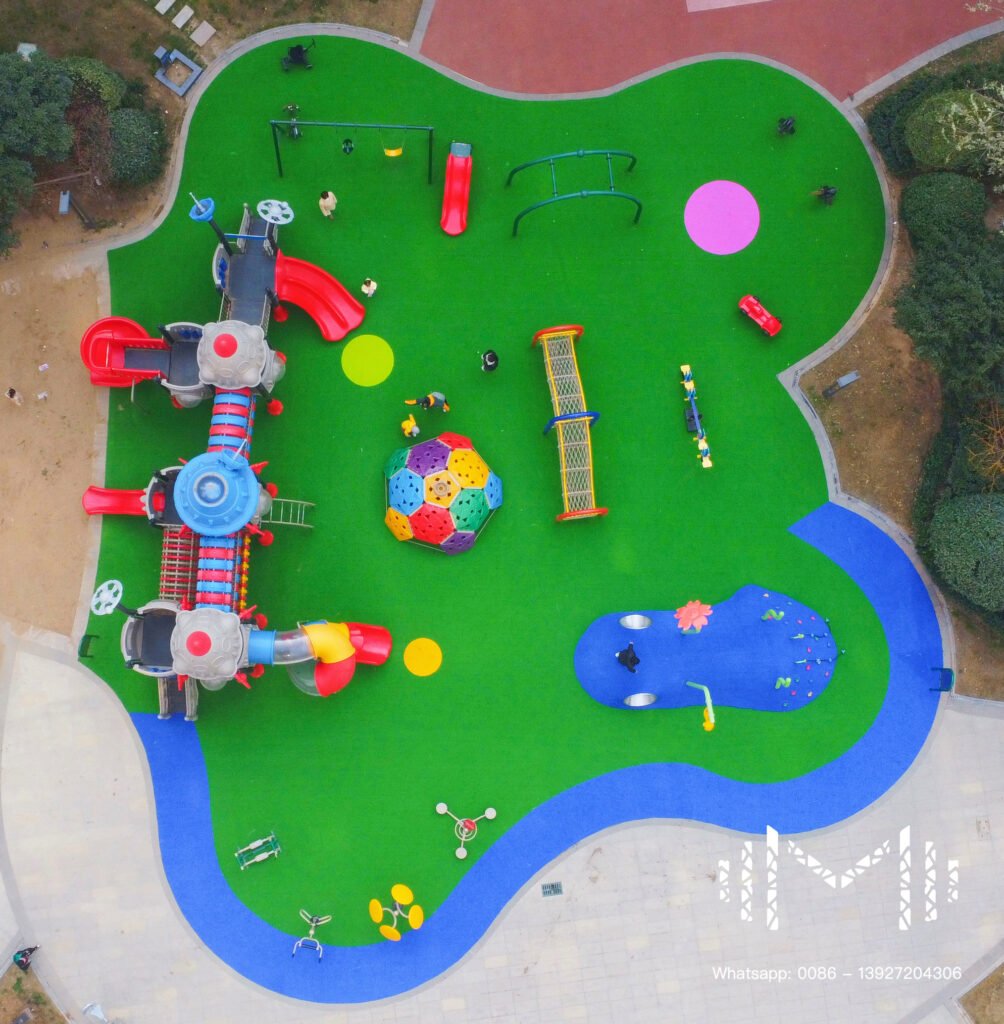
When creating a play space for kids, whether in the backyard, at a daycare, or in a community park, we all have one priority in mind: keeping our little adventurers safe while they explore and have fun. But here’s the thing – not all playground surfaces are created equal. And that’s precisely what we’re diving into today.
Have you ever watched kids play? They’re full of energy, jumping, running, and, let’s be real, taking the occasional tumble. That’s where outdoor rubber mats come into play (pun intended!). These mats are like the unsung heroes of playtime, offering a cushion for falls and a slip-resistant surface that keeps those little feet steady.
But it’s not just about safety – which, don’t get me wrong, is super important. It’s also about durability, maintenance, and, yes, even style. You want something that’s going to last through the seasons, be easy to clean, and not look like a drab piece of carpet thrown on the ground. Rubber mats tick all these boxes, making them a top contender for playground flooring.
In this post, we will explore why outdoor rubber mats might be the playground champion you’ve been looking for. From their longevity to their shock-absorbing powers, we’ll cover all the bases, giving you the lowdown on why these mats could be a game-changer for your outdoor play area.
So, let’s jump right in and find out why rubber playground mats are the talk of the town and how they can transform your playground into a safe, fun, and vibrant space for kids to enjoy day in and day out!

What Essential Safety Aspects Should Your Playground Surface Include?
Gather around, friends, because we’re about to break down the safety essentials that every playground surface should boast, whether it’s for a bustling commercial playground or a cozy corner in a residential setting. Safety isn’t just a bonus; it’s the foundation upon which all the fun is built.
Let’s kick things off with fall height ratings. This nitty-gritty number tells you how much of a knock your outdoor rubber mat for playground can handle while keeping the kiddos safe. It’s a critical figure, especially for rubber playground flooring, where the aim is to soften the impact from the highest slide or the most daring monkey bar jump.
Slip resistance is another non-negotiable. Rubber tile flooring isn’t just about looking sleek; it offers steadfast stability. This feature is the unsung hero that keeps little feet firmly planted, even when the inevitable spills and splashes happen. It’s the difference between a close call and a call for a band-aid.
Now, onto impact absorption. This is where materials like loose fill material come into play. They’re the unsung guardians against gravity, ready to cradle a child’s fall. Whether you opt for traditional dirt or the more modern rubber mulch, the goal is the same: to dissipate the energy of a fall and keep those playtime adventures as safe as they are thrilling.
When it comes to playground flooring options, the installation process is just as necessary as the material you choose. A professional install ensures that every square inch of your playground is designed to be a safe zone. It’s about providing the surface under the swings, and the slide is ready to do its job from day one.
Whether laying down the groundwork for a new community play space or upgrading your backyard, remember that the right surface—be it a plush layer of rubber tiles or a natural cushion of loose fill—can make all the difference. It’s about creating a space where kids can push the limits of their imagination without pushing the boundaries of safety.
Ultimately, the best playground is installed with care and designed with the ultimate trifecta of safety in mind: fall height ratings, slip resistance, and impact absorption. So, choose wisely, install carefully, and let the sound of carefree laughter be the testament to a job well done.

Which Playground Flooring Offers the Best Protection for Kids?
Hey buddy, let’s talk about keeping our little ones safe while they’re out conquering the jungle gym. When it comes to playground flooring, we’ve got more options than a kid in a candy store. But it’s not just about what looks good; it’s about what keeps those knee scrapes to a minimum and cushions the falls when gravity does its thing. Let’s break down the contenders, shall we?
First up, we’ve got the trusty rubber mats. These guys are like the all-weather tires of the playground world. They’re designed to absorb shock and are a top pick when it comes to meeting safety standards like the ASTM F1292, which is the geeky way of saying they’re certified to cushion falls from certain heights. Plus, they’re slip-resistant, making them a solid choice for areas that see a lot of rain or have water features.
Then there’s rubber mulch. This one’s a bit of a double agent—it looks like wood mulch but acts like rubber. It’s a fantastic pick for playground safety surfacing because it offers good fall protection, just like its rubber mat cousins. And because it’s loose-fill, it can be easier on the wallet when it comes to installation costs. Just remember that it needs a bit more TLC to keep the depth consistent for optimal safety.
Now, don’t overlook engineered wood fiber. This material is like the unsung hero of playground surfacing. It’s made from processed wood designed to knit together to create a firm surface that’s still soft enough for fall protection. It’s a natural look that’s easier on the budget and ADA-compliant, which is a big thumbs up for inclusivity.
Artificial grass has been making waves in the playground scene, too. It’s got that year-round green look that makes every day feel like spring. Regarding safety, it’s often installed with a cushioned underlayer, which can be tailored to meet those critical fall height ratings. Plus, it’s virtually maintenance-free, which means more play and less work.
But let’s remember poured-in-place rubber, the Cadillac of playground surfacing. This seamless option is custom-installed to your playground’s specs, offering consistent fall protection across the entire garden. It’s also a champ in the visual appeal department, with a rainbow of colors and designs that can match your wildest playground dreams.
So, what’s the verdict? Well, each of these playground surfacing options has its own superpowers when it comes to keeping kids safe. Rubber mats and poured-in-place rubber offer top-notch durability and uniform safety, while rubber mulch and engineered wood fiber bring a natural aesthetic and potentially lower installation costs. And artificial grass? It’s the low-maintenance, always-green safety layer that keeps things looking sharp.
In the end, the best protection for your playground warriors depends on your specific needs—like your budget, maintenance bandwidth, and, of course, the level of safety you’re aiming for. But one thing’s for sure: whether you go for mats, mulch, or something else, picking the correct surface is like giving your playground a superhero cape. It won’t just look great; it’ll be a fortress of fun where kids can play safe and sound.

What Ground Material Balances Safety With Visual Appeal in Playgrounds?
Regarding playgrounds, we’re not just looking for the toughest kid on the block; we want the whole package—safety and good looks. After all, a playground should be a place that beckons kids with its fun vibes and keeps parents at ease with its safety creds. Let’s check out which ground materials strike that perfect balance between being a feast for the eyes and a cushion for the falls.
Engineered wood fiber (EWF) is like that rustic, charming cottage in the woods—natural and inviting. It’s a go-to for that organic look, blending seamlessly with outdoor settings. But EWF isn’t just about good looks; it’s also about safety. When properly installed, it creates a soft, impact-absorbing carpet that’s kind to little knees and elbows. Plus, it’s got a fall height rating to write home about, making it a solid contender for safety surfacing.
Then there’s artificial grass, the evergreen wonder that keeps playgrounds looking manicured all year round. It’s soft, lush, and whispers “barefoot luxury.” But don’t let its posh appearance fool you; beneath that verdant exterior lies a shock-absorbent layer that’s all about keeping playtime injury-free. It’s like having a bodyguard dressed in a tuxedo—sleek, sophisticated, and ready to protect.

Now, let’s talk rubber—rubber playground tiles, to be exact. These are the modern artists of the playground world, available in a kaleidoscope of colors that can be pieced together to create any design you can dream up. They’re the perfect canvas for a playground that pops. But they’re not just a pretty face; these tiles are designed for heavy-duty action, boasting a high fall height rating and being virtually maintenance-free. They’re the perfect marriage of form and function, offering a safe, durable surface that can handle the pitter-patter of countless tiny feet.
So, what’s the best pick? Well, it depends on your playground’s personality. If you’re going for that natural, woodsy feel, engineered wood fiber might be your soulmate. Artificial grass could be your match for a clean, green look that’s soft underfoot. And if you want a vibrant, playful space that shouts “fun” from every corner, rubber tiles might be your playground’s better half.
In the end, the goal is to create a playground surface that doesn’t just whisper “safety” but also sings “come and play” with its visual appeal. Whether you choose the natural elegance of wood fiber, the polished look of artificial turf, or the bright and bouncy feel of rubber, you’re crafting a space that’s as inviting as it is secure—a place where kids can let loose and parents can relax, knowing their little ones are in good hands (and on good ground).

How Do Playground Surfaces Stand Up to Weather and Wear?
Navigating the elements is a big deal when it comes to selecting the perfect playground surface. You want a material that laughs in the face of a downpour and doesn’t flinch when the sun cranks up the heat. Let’s unpack how different surfaces hold up against the whims of weather, keeping those little feet safe and playtimes uninterrupted.
Outdoor rubber mats for playgrounds are the all-stars when it comes to weather resistance. These durable champs are designed with drainage in mind, allowing water to pass through so puddles don’t crash the playdate. When the sun’s rays are beaming down, many rubber playground tiles come equipped with UV protection to combat the heat, ensuring the playground equipment stays touchable and the surface comfortable for play.
But what about the natural look of wood chips or the eco-friendly choice of playground rubber mulch? These loose-fill materials are champions at natural drainage, letting water trickle through to the earth below. They do require a bit of upkeep to stay effective, especially in high-traffic areas where they can get displaced. Still, with a little TLC, they’re a cost-effective and visually appealing choice for commercial and residential playgrounds.
Then there’s the engineered wood fiber, a budget-friendly and earthy option for playground flooring. It’s got a knack for knitting together, creating a firm yet forgiving surface that’s safe for falls. While it can hold moisture a bit longer than its rubber counterparts, a well-installed base by a professional installer can mitigate any soggy situations.
Artificial turf, or synthetic turf, is another contender, especially for those seeking a year-round green, low-maintenance lawn look. Underneath that lush exterior lies a sophisticated drainage system that whisks away water, keeping the playground mat ready for action. And for those scorching summer days, innovative cooling infills can help keep the surface from turning into a hotbed.
Pour-in-place rubber is the tailored suit of playground surfacing. Customized to fit every nook and cranny of your playground area, it offers seamless and consistent safety flooring that’s unrivaled in fall protection. It’s an investment upfront, but the low maintenance costs and longevity save money in the long run.
Whether it’s the recycled rubber of playground tiles or the natural texture of pea gravel and sand, each material has its own way of dealing with water and temperature extremes. Loose-fill surfacing like landscape mulch can quickly fix public playgrounds, while poured-in-place solutions offer a bespoke fit for a higher installation cost.
Ultimately, it’s all about matching your needs with the right material. Do you prioritize a children-safe environment with a high fall height rating? Or is the visual appeal and low installation cost higher on your list? You may be looking for something that stands up to the daily stampede of tiny feet in high-traffic areas. Whatever your checklist, there’s a playground surfacing option ready to rise to the challenge, ensuring your playground doesn’t just look great but performs exceptionally, come rain or shine.

What Makes Outdoor Rubber Matting Ideal for Playgrounds?
So, what’s the big deal with outdoor rubber matting for playgrounds? Let me tell you; it’s like finding out your favorite superhero is also a whiz at babysitting—super reliable and exactly what you need when the stakes are high.
First off, rubber matting is tough. It’s like that friend who’s always got your back, come rain or shine. Made to withstand high traffic and the often harsh whims of Mother Nature, these mats are the long-lasting sidekick every playground needs. They don’t crack under pressure—or under the playful stomping of tiny feet, for that matter. And they’re not just tough; they’re also resilient. They spring back after each jump and tumble, ready for more action without showing signs of wear and tear.
But here’s the real kicker: safety. We all know that the sound of laughter can quickly turn into cries if playtime goes south. Rubber mats are designed with a soft, forgiving surface that absorbs the impact of falls—because, let’s face it, kids fall a lot. This cushioning effect is all about minimizing boo-boos, making them a must-have for any area where kids are being, well, kids.
And slip-resistant? Absolutely. Rubber mats come with textures that help keep those little feet stable, reducing the risk of slips and slides. Even when the rain pours down, creating a Slip’N Slide out of your average surface, rubber matting holds its ground, offering a grip that keeps playtime safe and sound.
But wait, there’s more. These mats aren’t just about keeping scrapes and bruises at bay but also about peace of mind. Many are made from non-toxic, recycled materials, meaning they’re a win for the environment and the health-conscious parent or caretaker. Plus, they’re a breeze to clean, meaning less time scrubbing and more time for anything else.
In a nutshell, outdoor rubber matting is the playground flooring MVP. It’s durable, safe, eco-friendly, and easy to maintain—everything you need to create a worry-free, fun-filled play haven for the kiddos.

Can Rubber Playground Tiles Withstand Harsh Outdoor Conditions?
So, you’re eyeing those rubber playground tiles for the kiddos’ new play haven and wondering if they can take on the might of Mother Nature? Let’s dive into how these rugged beauties stand up to the elements.
Rubber playground tiles are like the all-terrain vehicles of playground surfacing. They’re built tough to handle just about anything the skies dish out. Rain? They laugh in the face of a downpour with their superior drainage capabilities. Snow? They shrug it off with a non-slip surface that keeps tiny boots steady. And when the sun decides to turn up the heat, these tiles are ready with built-in UV resistance that says “Nope” to fading and “Bring it on” to scorching rays.
But it’s not just about enduring the weather; it’s about how these tiles maintain their integrity through season after season of temperature swings. The secret sauce is in the material itself—recycled rubber engineered to endure and thrive outdoors. This means no cracking in the cold, no melting in the heat, and all-around resilience that makes them a smart pick for any playground, whether nestled in a snowy mountain retreat or basking in the desert sun.
And let’s remember their cousins, the rubber mulch and poured-in-place surfaces. These products share the same tough DNA and come with their own set of superpowers. Rubber mulch keeps its cool when the thermometer climbs, and poured-in-place surfaces create a seamless shield against weather wear and tear.
In the world of outdoor play, rubber playground tiles are the quiet heroes, offering a safe landing for kids and peace of mind for parents. They’re the trusty sidekick that doesn’t blink at a little weather drama, ensuring that playtime never has to take a rain check.
So, can rubber playground tiles withstand harsh outdoor conditions? You bet they can. They’re the playground’s first line of defense against the whims of weather, making sure that rain, shine, or anything in between, the fun never stops.

What Thickness Is Optimal for Playground Rubber Mats?
Let’s get down to the nitty-gritty of playground rubber mats – their thickness. You might think, “A mat’s a mat, right? Why fuss over a few inches?” But here’s the scoop: when it comes to playground mats. Thickness isn’t just a number; it’s the secret sauce to safety and comfort.
Imagine you’re jumping off a swing (yes, we adults can still enjoy a good swing, no judgment!). The difference between a soft, cushioned landing and an “Oof, that’s gonna leave a mark” moment can come down to the thickness of the mat you’re landing on. That’s because the thickness of rubber mats directly correlates to their ability to absorb shock and impact. It’s like having a personal bodyguard for your little one’s knees and elbows.
So, what’s the magic number? Generally, you want to look at mats that are at least 2.5 to 3 cm thick for playground surfaces. This isn’t a random figure; it’s based on critical fall height ratings, which are a big deal in the playground world. These ratings tell you how high a child can be off the ground before the surface beneath them becomes a hazard in the event of a fall.
But it’s not just about cushioning those falls; thickness also plays a role in the overall feel and comfort of the playground. Too thin, and the kids might as well be playing on concrete. Too thick, and it can feel like wading through a marshmallow world, which, while fun, isn’t exactly practical for running and playing.
And here’s another pro tip: the sub-base is just as important. A solid, well-prepared sub-base ensures that the mat performs optimally. Skimp on this; even the thickest mat might offer a different protection than you’re counting on.
In essence, the optimal thickness for playground rubber mats is a balance between safety requirements and practical comfort. It’s about creating a space where kids can be kids—jumping, falling, and getting right back up without fear. So, when you’re picking out that perfect mat, remember: a few inches can make all the difference. It’s the difference between a good and great playground, where kids can soar to new heights with every leap and bound.

How Long Can You Expect Your Outdoor Rubber Mats to Last?
Let’s talk about the staying power of those outdoor rubber mats you’ve got your eye on for the playground. You’re investing in a fun and safe spot for the kiddos to romp around, so naturally, you’re wondering how long before you’ll need to reinvest in that vibrant, bouncy surface.
Outdoor rubber mats for playgrounds are like the trusty old truck that keeps trucking. They’re designed for the long haul, with a life expectancy that’ll make you smile. We’re talking years, not just seasons. Most of these rugged mats are in it to win it for a solid decade, and with some TLC, you could be looking at up to 20 years of service. That’s a lot of playdates and tag games!
But, as with all heroic tales, there’s a catch. The lifespan of your rubber playground mats can be influenced by a few essential sidekicks, namely installation, maintenance, and Mother Nature herself. A professional install can set the stage for a longer life by ensuring the mats are laid out just right, with no room for pesky water to pool or edges to trip up little feet.
Maintenance is your daily (or monthly) dose of care that keeps the mats in tip-top shape. A little cleaning here, a little inspection there, and you’re helping to fend off the wear and tear that comes with being the most popular spot on the playground.
And then there’s the weather. UV rays can be harsh on almost anything, and rubber mats are no exception. But here’s the good news: many of these mats have UV protection to fend off the harsh sun, keeping them from fading or becoming brittle.
So, what’s the bottom line? With the proper care and a little attention to detail, your outdoor rubber mats can be a part of the playground scene for years to come, offering a safe and vibrant spot for endless adventures. They’re a wise investment that pays off in giggles, games, and peace of mind, proving that the best playgrounds are built to last.

What Should You Know About Rubber Playground Flooring Maintenance?
Let’s roll up our sleeves and talk about keeping those rubber playground floors in tip-top shape. Like your favorite sneakers, these surfaces need a little love and care to stay fresh and functional. So, what’s the scoop on maintenance for these bouncy beauties?
First things first, rubber playground flooring is a champ when it comes to low maintenance. But “low” doesn’t mean “no” maintenance, right? Regular cleaning is vital. A simple sweep to clear away leaves, dirt, and miscellaneous debris will do wonders. A mild detergent and water solution can wash away any stubborn spots or spills for a deeper clean. Just be sure to rinse it afterward to prevent any soapy residue from becoming a slip hazard.
Now, if you’ve got poured-in-place rubber or rubber tiles, you’ll want to watch for any loose bits or edges that might pop up over time. An adhesive fix can prevent tripping hazards and keep everything looking neat.
For those of you rocking rubber mulch, please give it a good rake now and then to keep the depth even and ensure that the surface remains effective for impact absorption. It’s like fluffing a pillow — it keeps it comfortable and
practical.
And remember the seasonal once-over. Before the playground hits high season in the summer or winds down for the winter, take the time to inspect the entire surface. Look for signs of wear and tear, like cracks or thinning areas, especially in high-traffic zones like under swings or at the bottom of slides.
Regular maintenance can go a long way in extending the life of your rubber playground flooring. It’s all about being proactive rather than reactive. Keep it clean and safe, and you’ll keep it fun for years to come.

In wrapping up, investing in rubber playground flooring is just the beginning. A sprinkle of regular maintenance is vital to ensure these surfaces continue to offer a haven for play. Simple practices like sweeping, occasional washing, and routine inspections can vastly extend the life and appearance of your playground. By keeping up with these tasks, you preserve the quality of your investment and uphold the safety and joy it brings to every child’s day.
Remember, a well-maintained playground is a cornerstone of countless happy memories and the backdrop for many adventures to come. So, take care of it, and it will continue to be a place where laughter lives and fun never fades.


